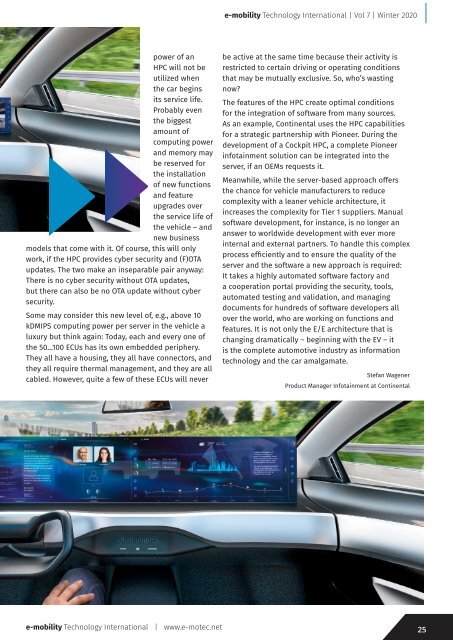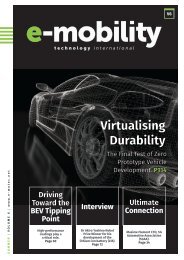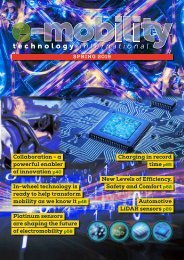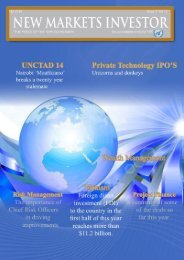E-mobility Technology Winter 2020
Electric vehicle technology news: Maintaining the flow of information for the e-mobility technology sector
Electric vehicle technology news: Maintaining the flow of information for the e-mobility technology sector
Create successful ePaper yourself
Turn your PDF publications into a flip-book with our unique Google optimized e-Paper software.
e-<strong>mobility</strong> <strong>Technology</strong> International | Vol 7 | <strong>Winter</strong> <strong>2020</strong><br />
power of an<br />
HPC will not be<br />
utilized when<br />
the car begins<br />
its service life.<br />
Probably even<br />
the biggest<br />
amount of<br />
computing power<br />
and memory may<br />
be reserved for<br />
the installation<br />
of new functions<br />
and feature<br />
upgrades over<br />
the service life of<br />
the vehicle – and<br />
new business<br />
models that come with it. Of course, this will only<br />
work, if the HPC provides cyber security and (F)OTA<br />
updates. The two make an inseparable pair anyway:<br />
There is no cyber security without OTA updates,<br />
but there can also be no OTA update without cyber<br />
security.<br />
Some may consider this new level of, e.g., above 10<br />
kDMIPS computing power per server in the vehicle a<br />
luxury but think again: Today, each and every one of<br />
the 50…100 ECUs has its own embedded periphery.<br />
They all have a housing, they all have connectors, and<br />
they all require thermal management, and they are all<br />
cabled. However, quite a few of these ECUs will never<br />
be active at the same time because their activity is<br />
restricted to certain driving or operating conditions<br />
that may be mutually exclusive. So, who’s wasting<br />
now?<br />
The features of the HPC create optimal conditions<br />
for the integration of software from many sources.<br />
As an example, Continental uses the HPC capabilities<br />
for a strategic partnership with Pioneer. During the<br />
development of a Cockpit HPC, a complete Pioneer<br />
infotainment solution can be integrated into the<br />
server, if an OEMs requests it.<br />
Meanwhile, while the server-based approach offers<br />
the chance for vehicle manufacturers to reduce<br />
complexity with a leaner vehicle architecture, it<br />
increases the complexity for Tier 1 suppliers. Manual<br />
software development, for instance, is no longer an<br />
answer to worldwide development with ever more<br />
internal and external partners. To handle this complex<br />
process efficiently and to ensure the quality of the<br />
server and the software a new approach is required:<br />
It takes a highly automated software factory and<br />
a cooperation portal providing the security, tools,<br />
automated testing and validation, and managing<br />
documents for hundreds of software developers all<br />
over the world, who are working on functions and<br />
features. It is not only the E/E architecture that is<br />
changing dramatically – beginning with the EV – it<br />
is the complete automotive industry as information<br />
technology and the car amalgamate.<br />
Stefan Wagener<br />
Product Manager Infotainment at Continental<br />
e-<strong>mobility</strong> <strong>Technology</strong> International | www.e-motec.net<br />
25









